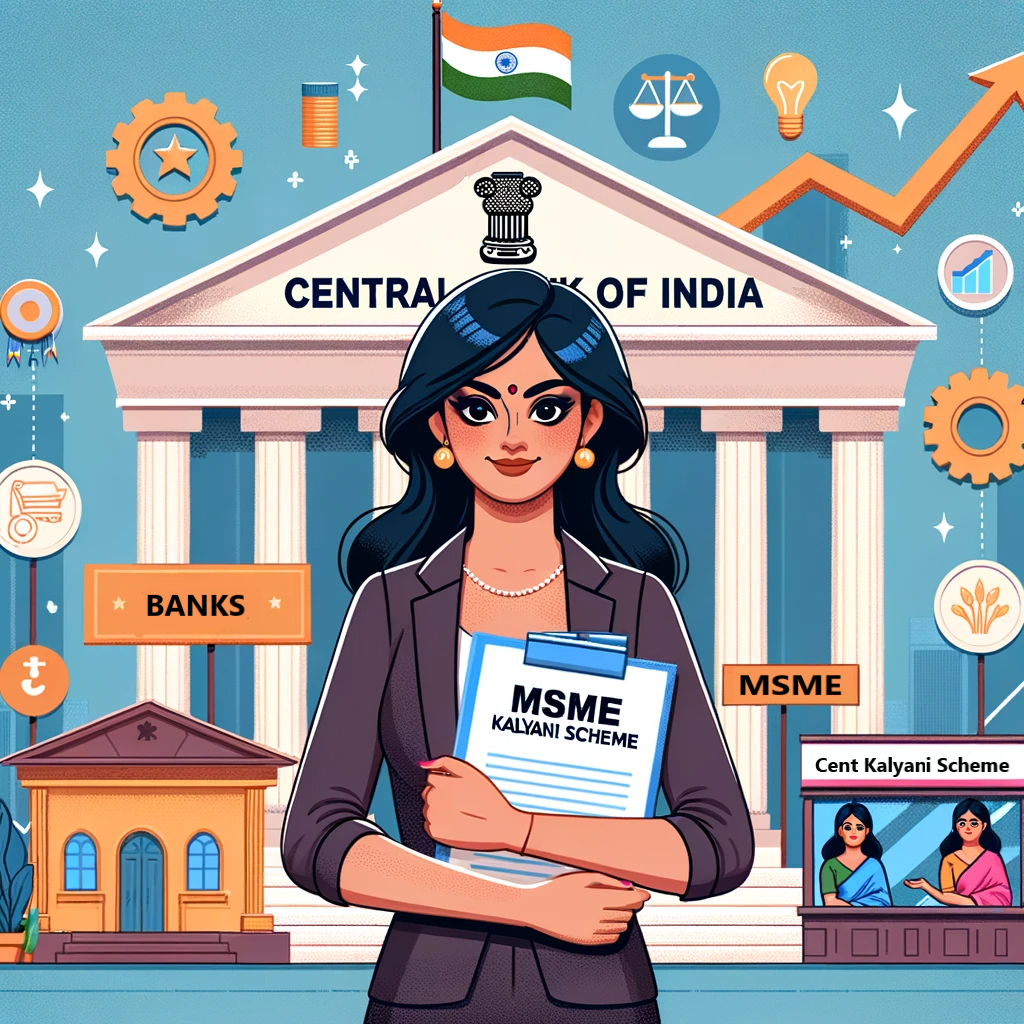From Struggles to Success: The Rise of Women-Owned Businesses in India with Cent Kalyani Scheme.

The Central Bank of India introduced the Cent Kalyani Scheme to foster sustainable and regulated employment opportunities for women entrepreneurs. The Cent Kalyani Scheme aims to help female entrepreneurs launch new ventures or enhance and expand their existing ones. This project provides various help to women entrepreneurs in the form of capital expenditure on plant or machinery as well as day-to-day business expenses.
Women-owned firms face several challenges, with finance being a primary concern. Traditional corporate attitudes towards female entrepreneurs often place them at a funding disadvantage. As a result, the Government of India has created several financial possibilities to encourage female entrepreneurship. The government banks have come out in support of women entrepreneurs, offering them low-interest loans through various schemes.
According to a World Bank survey, the percentage of enterprises with female participation in ownership is 10.7 percent, and recent data suggest a steady increase in the number of start-ups formed by female entrepreneurs.
The Cent Kalyani Scheme seeks to maximize the potential of female entrepreneurs to foster creativity, economic expansion, and job creation.
Women Entrepreneurs in India
As the Indian economy continues its upward trajectory, there has been a surge in the number of start-ups and new businesses. However, women entrepreneurs often face greater challenges in establishing businesses on their own. They confront significant hurdles due to prevailing cultural biases and limited access to corporate resources. The inherent gender imbalance in Indian society has historically hindered women from realizing their full potential. The steps to close the gender gap could result in a 6.8 percent increase in India's Gross Domestic Product (GDP).
Analyses suggest that promoting gender equality in India could boost the country's GDP by $0.7 trillion by 2025, a 16 percent increase from current projections. Furthermore, harnessing the economic potential of women in India is critical to achieving the Sustainable Development Goals (SDGs) by 2030.
Despite robust economic growth and an increasing population of working-age women in India, their participation in the labor force declined from 35% in 2005 to 26% in 2018.
The proportion of women in leadership positions is as low as 9%. In India, unequal education and the gender divide are impeding women entrepreneurs. According to the World Economic Forum's Gender Gap Report, India ranks 142nd out of 149 countries. Nevertheless, the government has created various institutional plans to boost women's entrepreneurial impulses, and there is a strong political desire and inspiration to enhance the statistics of how many women own firms.
The Significance of Promoting Women Entrepreneurs in India:
''No country will ever genuinely prosper if it stifles the potential of its women and denies itself the contributions of half of its inhabitants,'' Michelle Obama rightfully states. While women constitute half of India's total population, their participation in the workforce remains limited. Women-owned companies are mostly unstructured and limited to the agricultural sector, where women's growth potential is limited.
Although Indian women are seen as potential economic assets, their capabilities remain largely untapped. Despite existing structural and societal barriers in India, women entrepreneurs have made significant strides in enhancing female participation in the broader economy.
Recent studies indicate that bridging the gender gap and fostering women's entrepreneurship in India could lead to a 6.8% increase in the nation's GDP. The government has always supported the transition of women entrepreneurs through various schemes and initiatives aimed at developing skills and creating jobs. The Cent Kalyani plan is also one of the government bank's initiatives to encourage women to pursue their entrepreneurial goals while contributing to the Indian economy's overall growth.
What is the Cent Kalyani Scheme?
Through the branches of the Central Bank of India, the Cent Kalyani Scheme provides lending solutions tailored for micro, small, and medium-sized enterprises. The Scheme's intended beneficiaries are female entrepreneurs.
The main goal of the Cent Kalyani Scheme is to aid female entrepreneurs in expanding their current businesses and setting up new MSME units.
Businesses wishing to apply for the Cent Kalyani Scheme must meet the definition of an MSME as defined by the MSME Act of 2006. The company must be involved in either service or manufacturing. The Cent Kalyani Scheme does not cover retail trade or educational institutes. Self-help groups are likewise not covered under the Cent Kalyani Scheme.
Criteria for Eligibility in the Cent Kalyani Scheme:
The following people are eligible for the Cent Kalyani Scheme:
- The business entity should be compliant with the MSME Act of 2006.
- Female entrepreneurs who wish to start or expand an existing MSME unit are eligible to apply.
- The female entrepreneur must be an Indian national.
- Professionals who work for themselves, such as doctors, architects, and chartered accountants.
- Handloom, handicrafts, catering services, garment manufacture, beauty parlors, tailoring units, STD booths, photocopying centers, and transportation operators are among the businesses.
Documents required for Cent Kalyani Scheme:
Applicants for the Cent Kalyani Scheme must supply the following documentation to the bank for the loan to be processed:
- Identification documents such as Aadhar Card, Passport, PAN Card, Driving License, and Voter ID card.
- Address Proof: Aadhar Card, Passport, Voter ID card, electricity bill, and property tax receipt are all acceptable papers.
- Income Proof: Income Tax Returns must be provided to the bank for income proof, audited balance sheet, and Profit and loss Account.
- Proof of Business Existence: To confirm the operation of the business, applicants must present a unit profile and any relevant hypothecation documents to the bank.
How to Apply for the Cent Kalyani Scheme?
- Application Form
To begin, you must get an online application form from the official website of the Central Bank of India.
- Documentation is required.
Prepare the necessary documentation to guarantee a smooth application procedure. The forms must be correctly filled out. Deposit the appropriate documents and forms at the nearest Central Bank of India branch.
Conclusion:
We encourage MSMEs to explore the vast opportunities presented by "Acehours" as a gateway to unlocking their maximum potential, thereby making a positive impact on our nation's economic advancement. As we continue to provide valuable insights and support, we look forward to witnessing the success stories that emerge from the dynamic and resilient world of MSMEs. Together, we can build a brighter, more prosperous future for all.




